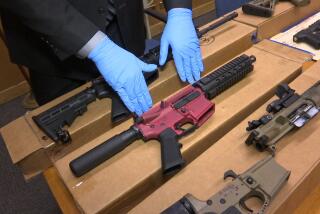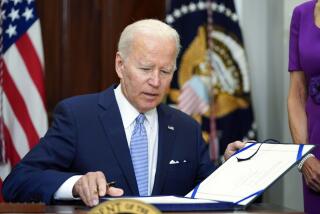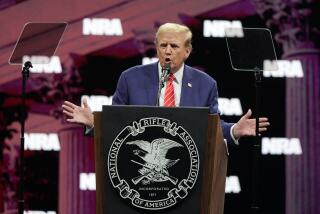Limiting ghost guns, pistol braces and spurring red-flag laws: What Bidenâs proposing

In his first major gun control measures since taking office, President Joe Biden announced executive actions Thursday aimed at addressing what the White House calls a âgun violence public health epidemic.â
WASHINGTON â After several mass shootings on his watch, President Biden has announced his administrationâs first steps toward greater gun regulation, declaring that âprogress, even on this most difficult of issues, is possible.â
The executive actions are limited â many of the goals of groups that advocate more restrictions would require new legislation from Congress, which remains stalemated on gun issues. But Biden, Vice President Kamala Harris and Atty. Gen. Merrick Garland portrayed the moves as a significant first step.
âSolutions exist,â Harris said in introducing Biden at a White House event Thursday. âPeople on both sides of the aisle want action ⌠all that is left is the will and the courage to act.â
âEnough, enough, enough,â Biden said, noting that more than 100 Americans on average die from shootings each day. âThis is an epidemic, for Godâs sake, and it has to stop.â
Hereâs whatâs in the plan:
âGhost gunsâ
The action with the greatest potential to limit the number of new guns in circulation is a proposal to require background checks for so-called ghost guns.
The label refers to do-it-yourself kits, widely sold, that allow a person to manufacture a functioning weapon at home using readily accessible tools. Because existing rules donât consider such kits to fall within the definition of âfirearmsâ under federal law, they are not required to have a serial number, unlike completed guns. That means they canât be traced by law enforcement agencies, which is why theyâre called ghosts. For the same reason, no background check is required to buy one.
Such kits were relatively rare a decade ago but have become much more available. Law enforcement officials in California and other states say they are increasingly finding such untraceable weapons at crime scenes.
Under California law, starting in 2024, all such gun parts will have to be sold through a licensed gun dealer and will require a state background check.
A report last year by the advocacy group Everytown for Gun Safety said there were 80 active sellers of ghost gun kits online, most of which had started in business since 2014. The report said 26 states had at least one seller. In California, the report identified 18 sellers.
The kits are often marketed as allowing a purchaser to produce a weapon in as little as two hours. In some cases, the gun parts are sold along with the drill bits and other tools needed to complete the work.
âThis issue of ghost guns makes just about every law that we pass null and void,â said Rep. Lou Correa (D-Santa Ana), who attended Thursdayâs Rose Garden annoncement. As gun kits become more prevalent, criminals can effectively bypass existing laws requiring background checks, he said.
Bidenâs plan directs the Justice Department to come up with a new rule that defines the kits as firearms under federal law. That would require purchasers to go through a background check.
The rule would have to go through the standard public comment process before it could become final. Once it does, sellers of gun kits will probably challenge the rule in court, arguing that current law canât be stretched to cover their products.
The test under federal law is whether a gun part âmay be readily convertedâ to use in a functioning weapon. Starting in the mid-2000s, the Bureau of Alcohol, Tobacco, Firearms and Explosives began issuing letters to marketers of many kits saying that the gun parts they sold did not meet that legal test and were not regulated as firearms.
Violence prevention
The number of shootings has risen sharply in many major cities around the county in the last year, as Biden acknowledged.
The causes of that increase have been hotly debated. The COVID-19 pandemic, and the economic disruptions and school closures it caused, may be one factor. Another factor in some cities may be changes in law enforcement since the mass protests last summer after George Floyd died at the hands of police in Minneapolis. Some of the increase may simply be random fluctuation.
Whatever the cause, the increase in gun violence poses a challenge for the Biden administration. Keeping American cities safe is a political imperative for the urban-based Democratic Party. At the same time, Bidenâs administration is committed to reducing the number of people in prison and not returning to the tough-on-crime posture of the 1990s.
âGun violence is not a problem that law enforcement alone can solve,â Garland said Thursday.
Thatâs led to increased administration support for what the government calls community violence intervention programs.
Such programs begin with a basic fact that also undergirds a lot of urban crime-fighting strategies: âA relatively small number of people are involved in urban gun violence, whether as perpetrators or victims,â and the violence is concentrated in racially segregated neighborhoods with high levels of poverty, as a White House fact sheet put it.
Policing strategies try to identify that small number of people and keep them under law enforcement scrutiny, which has led to accusations of racial profiling and police harassment.
Violence prevention programs, in contrast, aim to resolve disputes before they turn violent, connect people at high risk for violence with job openings or training, and take other steps such as working with shooting victims while theyâre still hospitalized to head off retaliatory violence.
Administration officials say those strategies have shown promising results where they have been tried, but the programs have been chronically underfunded. The administration aims to reverse that by investing $5 billion over the next eight years as part of Bidenâs infrastructure plan.
âFor a fraction of the cost of gun violence, we can save lives,â Biden said, noting that gun violence costs the U.S. billions of dollars each year in hospital bills, lost productivity and prison expenses.
While Congress works through that plan, Biden hopes to provide money from existing programs. Heâs directing some two dozen federal agencies to examine their programs to see which could be used to support violence-prevention efforts.
âRed flagâ laws
In recent years, 19 states, including California, have passed âred flagâ laws. These statutes allow family members or law enforcement agencies to go to court to request an order that temporarily takes guns away from someone who is suffering from mental problems or other issues that would make them a danger to themselves or others.
Biden is not proposing a federal red flag law, although the White House says he would support one.
For now, his administration will propose a model statute that states could adopt. Backers hope that the existence of a model will make it easier for states to pass such measures, which has been true in a wide range of other areas of law.
Stabilizing braces
The gunman who shot and killed 10 people last month in Boulder, Colo., used a pistol equipped with a stabilizing brace. Such a brace in effect transforms a pistol into a short-barreled rifle, making it more accurate while still allowing it to be more easily concealed.
Short-barreled rifles have been subject to strict regulation for years, including a $200 tax and federal registration. Bidenâs plan directs the Justice Department to come up with a new rule within 60 days that would make such stabilizing devices subject to similar restrictions.
Gun trafficking
Biden will direct the ATF, the governmentâs main agency that regulates gun sales, to produce an annual report on trafficking of firearms. The ATF produced such a report in 2000, but trafficking patterns have since changed significantly, and the report hasnât been comprehensively updated, White House officials say.
Times staff writer Sarah D. Wire contributed to this report.
More to Read
Get the L.A. Times Politics newsletter
Deeply reported insights into legislation, politics and policy from Sacramento, Washington and beyond. In your inbox three times per week.
You may occasionally receive promotional content from the Los Angeles Times.











